November 10, 1923 -On to Memphis-Centre-Sewanee

The "Grid-Graph" was to "carry" the game in the gym at Centre
The week after the Kentucky game, the Danville "Advocate" received a letter from "its good friend," Colonel Robert E. Burton, who was visiting in Waterloo, Iowa. Colonel Burton reported that he was listening to some men in a restaurant talking about football, and one asked, "Where in the world is Danville, Kentucky?"
Another diner, a big husky fellow, looked up, astonished.
"Why you darn fool. Danville is located in Centre College, the place where Uncle Charlie Moran presides, and Bo McMillin and Red Roberts trained."
The "Advocate" added a comment.
"That big guy, shore do know his jargfy."
Centre's next game was with a school which was somewhat of a mirror of itself, The University of the South, more commonly known by Sewanee, for the small Tennessee mountain town which was its home. The two little colleges both had Protestant backgrounds, with Centre being formed by Presbyterians and Sewanee by the Episcopalians. Both had a history of playing and defeating schools which far exceeded their own enrollments and had achieved renown for one epic event which had put their football programs and schools on the map.
Of course, for Centre, it was the monumental October 29, 1921 win over Harvard, 6-0.
For Sewanee, it was not just one history-making game, but an entire season in which the Tigers dominated the South in 1899 by going 12-0 and outscoring their opponents, 322-10.
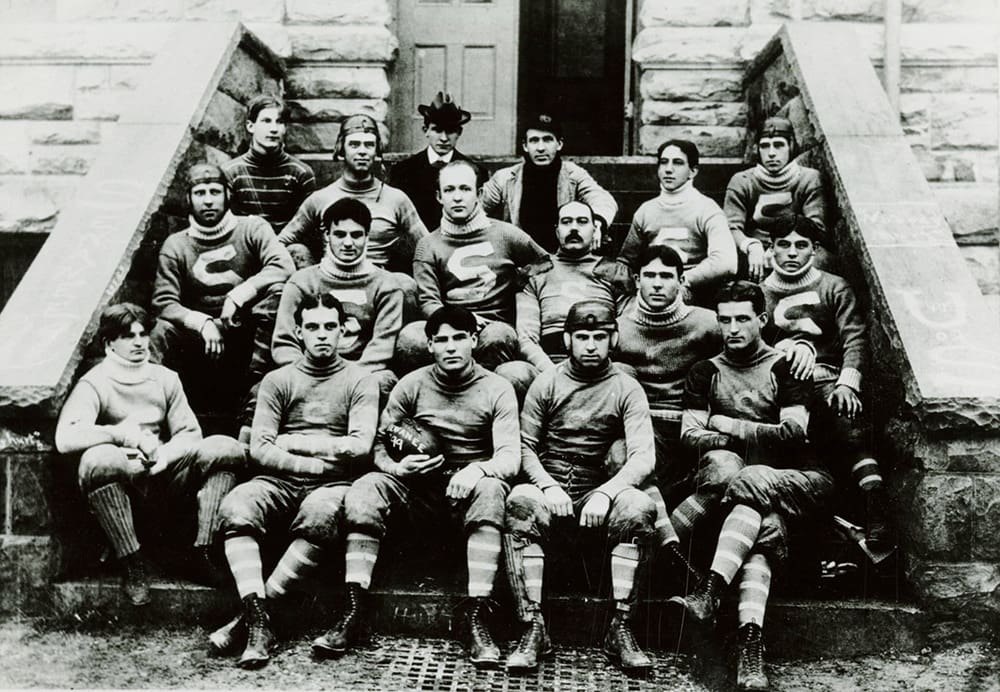
Sewanee Tigers with approximately 100 students in 1899
The 18-member 1899 Sewanee team, known as the "Iron Men," made a ten-day, 2,500 mile trip by train, and in 6 days from November 9 to November 14, defeated Texas in Austin, Texas A&M in Houston, Tulane in New Orleans, LSU in Baton Rouge, and Ole Miss in Memphis, before returning home.
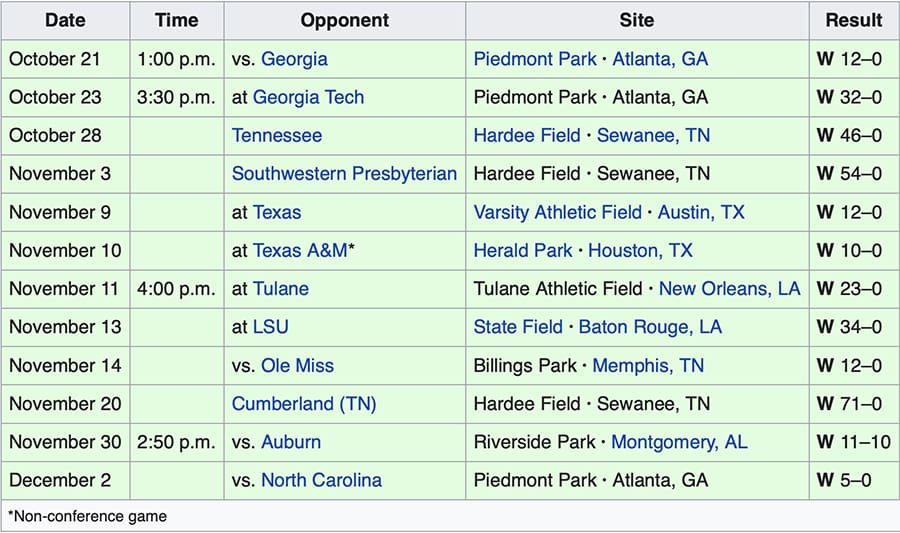
1899, a monumental season for Sewanee
Even more remarkably, each of the 5 games was a shutout!
Centre and Sewanee had met in Chattanooga in 1917, Uncle Charlie's first year at the helm, and the Colonels had bottled up the Tigers' star, Eben Wortham, and won, 28-0. Now, 6 years later, the two teams were again going to meet on a "neutral" site, Memphis, at that time the largest city in Tennessee, located on the Mississippi River in the far southwestern part of the state.
Why Memphis?
Because the sports fans in the city were much like those in Louisville. They were "mad" for football.
The previous year, the civic leaders of Memphis had contacted Centre and made a very attractive offer for the Colonels to come to their city. They said they'd secure a suitable opponent, one from Tennessee, and Centre sent back word that the offer seemed perfectly suitable, and the school would like to come to Memphis as long as the opponent was a member of the Southern Conference.
The reasoning was that Centre wanted to meet a member of the conference which hopefully could be defeated, and be part of the school's claim to being the best team in the South.
That narrowed the candidates to 3 possibilities; Tennessee, Vanderbilt or Sewanee.
The organizing committee in Memphis was able to get Sewanee to sign on.
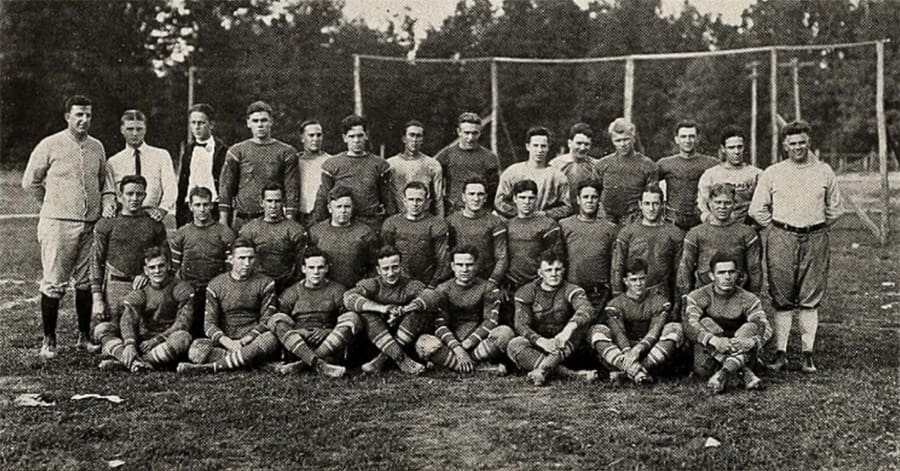
1923 Sewanee Tigers
Memphis simply hadn't had access to any big-time football. There was a college named West Tennessee Normal College which had been chartered in 1909, and opened its doors in 1912.
This college evolved over the years into West Tennessee State Teacher's College in 1925, Memphis State in 1941, and became known as the University of Memphis in 1994.
To use the terms "West Tennessee Normal" and "big-time" in the same sentence was actually an oxymoron. In 1922, when plans were fermenting to bring Centre to Memphis, West Tennessee Normal actually was competing at a level where two high schools from Arkansas were on the schedule, and the college just managed to tie both Blytheville High and Wilson High.
If a Memphian wanted to step up to a higher level of college football, it was necessary to travel south 50 miles to Oxford, home of the University of Mississippi. The last game of any real significance in Memphis was in 1915 when Vandy slaughtered Ole Miss by the remarkable score of 91-0.
Centre was a natural for Memphis, the promoters reasoned. Centre had beaten Harvard, Harvard represented the North, and Memphis was about as Southern as it got. Centre would fill any stadium where the game could be scheduled, as folks from Memphis already had developed affection for the slayers of the big, Northern power.
Sewanee was also an ideal opponent due to the significant number of loyal alumni who lived in the river city, and it was both a member of the Southern Conference and from Tennessee.
Centre couldn't do anything on the Monday after the Kentucky game but work out in sweat suits. The field had been so muddy that the team changed into their practice uniforms at the half of the Kentucky contest, and the managers were still trying to get the two sets of moleskins scraped off so they could be washed.
Tuesday, things got back to normal, but a surprise arrived in the form of a telegram to Captain Kubale. "Kube" opened the envelope and read it with astonishment.
Jop was there.
During the past few years, the Centre Colonels have been invited to radio contests, boxing matches, dinner and theatre parties, luncheons, dances and what nots, but the climax came today when Captain Kubale received a telegram from a Southern debutante asking the team to be her guests at a tea Friday afternoon at her home in Memphis.
George Chinn, an A-1 tea hound around Mundy's landing, a popular spot to hang out along the Kentucky River north of Danville, urged Kubale to wire back an acceptance.
The captain decided to put the invitation to a vote.
Chinn stood up to make his case.
"There's very little difference between a tea and a weenie roast, except the nourishment served, " was Chinn's reasoning.
The vote was 27-1 not to accept. Chinn voted.
The "Grid-Graph" was going to be set up in the gym from now on, starting with the Sewanee game, according to the "Advocate." Spectators said the sun made it too difficult to see, and also, the gym could be heated, and Cheek Field couldn't. The cost to "watch" would be 50 cents.
Centre's freshman team was going to play Sewanee's first year men down in Sewanee while the two school's varsity teams were pairing off in Memphis. The logistics were worked out by agents from the Southern Railroad and the L&N who came and met with the Centre authorities.
The freshmen were to take the Southern to Chattanooga, then transfer at the big Southern station to the Nashville, Chattanooga and St. Louis line to ride up the mountains to Cowan, where they would follow the Mountain Goat route into Sewanee. There would be 20 players on the Lieutenants' squad, and the team was to be coached by Jim Kendrick. Assistant student manager, sophomore Eugene Roemele, was going to take care of the equipment and tape ankles.
The varsity was going to have a skull session and light workout Thursday afternoon, change into their traveling clothes, have dinner and be driven the few miles south to Junction City where the L&N had a small station. The college had chartered a Pullman for the trip which would be left on a siding at the station while the team was in Memphis. The railroad had assigned a ticket agent to accompany the team on the trip, making certain that all of its needs were met.
There were 22 varsity players, coaches Moran and Cregor, faculty representative, Dr. A. E. Porter, two student managers and a student trainer on the 14 section sleeper.
Amazingly, little Centre College was sending 42 players, three coaches, 4 student managers/trainers and a faculty rep to play football in two locations during the weekend of November 10, 1923, 50 people in all.
To get to Memphis from Danville, one had to take a somewhat indirect route. From Junction City, the Pullman of the Colonels was hooked onto a passenger train heading north to Louisville. The team pulled away on the first leg at 6:30 in the evening, arriving at the L&N's 10th Street Station at 10:00 P.M. The players were able to get off for a few moments and greet well-wishers while their car was joined to a southbound L&N train which was going to and through Bowling Green, Kentucky. They slept through another uncoupling and connection there, being joined to a west bound L&N train which carried them all night toward Memphis, and arrived well rested the next morning.
The trip had taken approximately 15 hours, a relatively short journey when compared to the marathon ventures to Boston and Philadelphia.
The team was transported to the 8 story, 400 room Chisca Hotel, built in 1913, located at 272 South Main, and had a hearty breakfast. Then there was free time to explore the downtown which the coaches always tried to find time for the team to do.
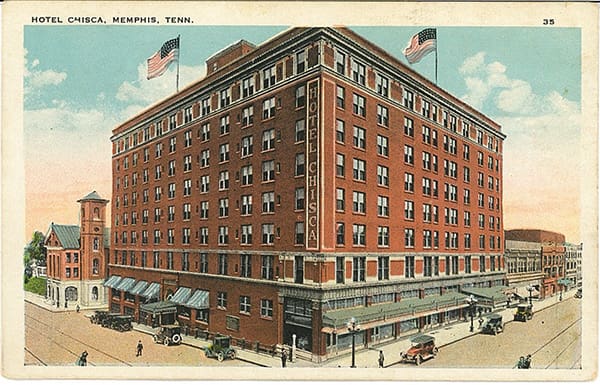
Hotel Chisca, team headquarters for Centre
"We want you to see the country, and get out and walk and explore when we get into new places," the Chief had said many times. "We travel to play football, but we also travel to broaden our knowledge about different parts of the country."
When one looks back on all of the experiences that Centre's team had, there was arguably no college in the country that gave the members of its football team such a wonderfully broad education through travel. One advantage of not having had a stadium of significance until 1923 was that Centre had to travel, and the team's many journeys took the young players to all corners of the country.
After the sightseeing, the Colonels traveled to Russwood Park, scene of the next day's game.
There was a light workout, and the Sewanee team arrived just as Centre was leaving. The players mingled a while, and made small talk about common opponents they had met during the year.
Both of the two schools had played Carson-Newman and Oglethorpe, and when comparable scores were analyzed, Centre would have appeared to be the favorite.
Centre 14 Carson-Newman 0
Sewanee 0 Carson-Newman 0
Centre 29 Oglethorpe 0
Sewanee 13 Oglethorpe 0
Overall, Sewanee was 4-2-1 going into the Centre game and had played well against a strong Alabama team ( 7-2-1 ), and Texas A&M ( 5-3-1. ) Alabama was played in Birmingham and A&M in Dallas.
Sewanee 0 Carson-Newman 0
Sewanee 3 Howard 2
Sewanee 34 Southwestern 0
Sewanee 0 Texas A&M 14
Sewanee 0 Alabama 7
Sewanee 13 Oglethorpe 0
Sewanee 26 Chattanooga 0
Friday night, the Memphis Chamber of Commerce arranged a special performance at the Lyric Theatre for both teams. The "Dixie Revue of 1923" was the feature, and special boxes for the Colonels and Tigers were "the best seats in the house."


The Lyric Theater
On Saturday, November 10, the day before the celebration of Armistice Day, and the 5th anniversary of the end of the slaughter that had been the result of the Great War, the Colonels awoke to find a city decked out in red, white and blue.
There were flags all over the hotel, inside and out. The local citizens had also unfurled many a Confederate flag. It was 58 years since the "War of Succession," and many old soldiers who had worn the Gray of the Rebel Army were still alive and well all over the South.
After a light breakfast, there was a skull session at the Chisca. Uncle Charlie gave a speech at the end of the session, reinforcing the importance of the game.
"We can be the best team in the South. We have defeated Clemson. We have defeated Kentucky. If we win over Sewanee, we have a good shot of running the string out against the rest of the Southern teams on our schedule. If we were to lose today," and Uncle Charlie paused for effect, "it won't make any difference what we do against Auburn, or Washington and Lee, or Georgia. If you play like you did last week against Kentucky, if you play eleven men as one, you can beat any team in the country."
Captain Kubale, in his quiet way, urged his teammate on.
"We are Centre. And Unc, we will play as one. We are ready."
The team picked up on their captain’s words.
"We are Centre! We are Centre! We are Centre! We are Centre!"
There were three cheers, and it was off to Russwood Park.
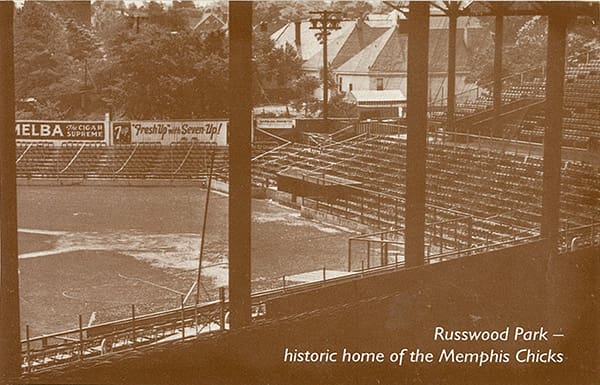
Field where the 1923 Sewanee game took place used for both baseball and football
The game was sold out. The 11,500 seats were taken, and a large number who didn't have a ticket paid for standing room. The ballpark was brightly decorated with the Stars and Stripes, Centre's gold and white, and the purple and white of the Sewanee Tigers. The crowd contained students from several high schools in the area. Both Centre and Sewanee had agreed to the Chamber of Commerce's arrangement of inviting the students as it was felt attendance at the game may serve as a possible recruitment tool for future enrollees.
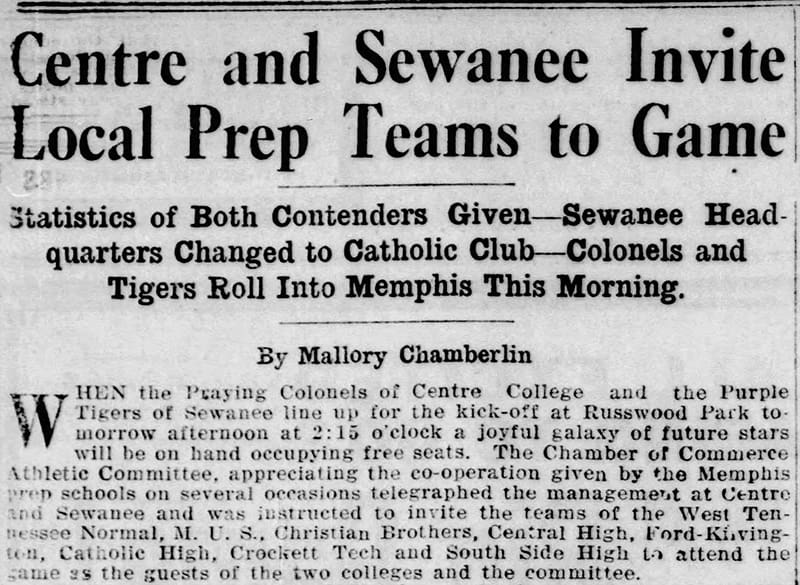
Eight high schools' teams invited to the game
Memphis truly was- "Mad for football!"
The Colonels were met with the enthusiastic applause they were used to when they came out on the field for warm-ups, but the Tigers were even more warmly greeted, which was to be expected, as they were the Tennessee team, even though Sewanee was some 300 miles east of Memphis.
Centre won the toss and received. The Colonels couldn't do anything and Albert Spurlock punted. The sophomore from Mount Cory, Ohio, boomed one of his best ever kicks, with great height and distance. The "hang time" allowed Centre's downfield men to reach the ball just as a Tiger back named Powers fielded it. A hard hit popped the ball loose, and Frank Rubarth covered it on the 13. Hope Hudgins got 11 around end, and on the next play, he popped through the line and scored.
Lemon was errant on the extra point, but the Colonels quickly led, 6-0.
Sewanee was no pushover and fought back, especially playing tough, hard hitting defense. Centre's defense was even more impenetrable. The quarter ended, 6-0.
The second period was basically a punting contest between Spurlock and Sewanee's Sanders. The crowd was brought to its feet by an electrifying 50 yard run by Herb Covington, but a holding penalty nullified the great effort by the Colonels' quarterback.
The Tigers never got past midfield during the half, and managed only one first down during the first 30 minutes of play, which ended, 6-0.
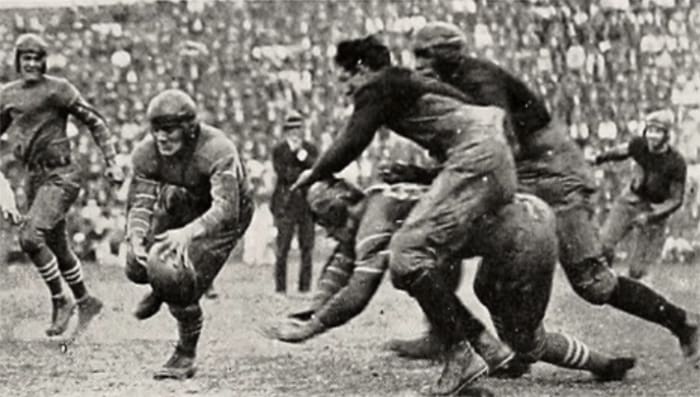
Centre back running with excellent block on Sewanee player
At the half, there was a stirring performance by the brass band hired by the Memphis promoters. One patriotic song after another was capped by the traditional, "Dixie," which was met with rebel yells and prolonged cheering, resembling the reception that the "Southern Anthem" received in New Orleans in 1921.
Sewanee chose to kick starting the second half, and a most unusual play ensued. The big Tiger fullback, Sanders, placed the ball down, and I.H. Dearing, a reporter covering the game, described what happened.
Sanders, kicking off for Sewanee, furnished a unique sight seldom if ever seen. He braced himself well in order to send the ball far into Centre territory, swung his foot, and missed clean.
Centre gained possession after the officials went to the side of the field and had a long conference. One of the refs later said, "We really were somewhat confused about how to call it because, quite frankly, none of us had ever seen a kicker totally miss the ball. Maybe just squib it, yes, but totally miss it, no. We decided the ball should go over to Centre, and there was no protest from Sewanee, because none of their people had ever seen something as strange as that either."
On the first play after the whiff, as Centre took over on the Tiger's 40, Kubale fired a center pass back but Hope Hudgins had broken the wrong way. "Blood" Miller, Sewanee' s left end, scooped up the free ball on the 50 and raced unmolested for a score. The extra point was no good, and it was 6-6.
Everyone agreed that it was a weird way to start a half, to say the least.
Uncle Charlie and the Centre bench had remained absolutely calm, much as had been the case after the TCU touchdown in the bowl game of January 1, 1921. As in Fort Worth, Uncle Charlie simply clapped his hands and said, "That's ok boys. Now take it to them."
Centre got to work immediately. Covington directed the offense brilliantly, alternating runs and passes. Hudgins made some timely gains. Near the goal line, Covey squeezed through the line and took it in. The Tigers were fighting furiously and on the score, two of their team members didn't get up. Captain Cooper Litton had hit Covey hard as the quarterback fell across the line and remained motionless on the ground, blood gushing from his nose. He was out cold.
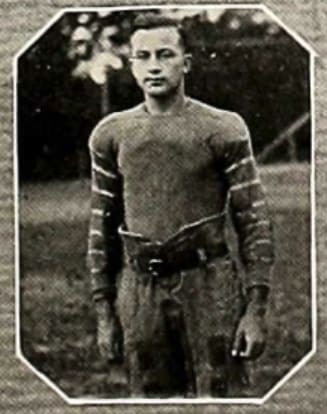
Sewanee's Cooper Litton
Another Tiger, George Millard, was writhing on the turf, rocking back and forth and clutching at his arm.

George Millard
The crowd was absolutely silent as what seemed like every doctor in Memphis rushed out on the field. An ambulance was called, and by the time it got to the field, Litton, though still dazed, was beginning to respond. Both players were placed on stretchers and transported to Baptist Hospital.
Captain Litton was a Memphis boy and after his nose was straightened and taped, he was discharged to his parents. Millard, with a broken shoulder, remained in the hospital.
Neither returned to Sewanee for several days.
After everything settled down, Lemon kicked the extra point and Centre led 13-6. Near the end of the 3rdquarter, Covey again directed a drive which culminated with a 25 yard TD pass to Hennie Lemon. The Colonels were somewhat lucky on the play as Powers tipped the ball and it floated over to Lemon who somewhat casually let it drop into his hands and he backed up a step and over the goal. His kick made it 20-6.

Memphis "Commercial Appeal" newspaper coverage
That was the final score. Sewanee had heart and never gave up. Once, near the end of the game, the Tigers drove to the 1-yard line but Frank Rubarth made a stunning hit on the first and goal play, the ball popped loose, and Centre recovered, ending the last threat by Sewanee.
It had been a dogfight, a clean game marked by few penalties. Besides the two injured Tigers, Covey and Hudgins limped off the field. The crowd stood and cheered and waved to the two teams as they congratulated each other and finally left the field, arms over shoulders, with pats on the back, and hands firmly shaken with smiles and best wishes.

A broken shoulder, broken nose and a concussion
It was college football as it should be played, between two small schools which competed in a manner far beyond their size, and everyone felt it a shame that either had to lose. Sewanee and Centre played many times after the Memphis meeting. Both schools faded from the big time, but their sportsmanship and dedication to the game has continued as members of the Division III, Southern Athletic Asociation, and the teams now have over 100 years of football experiences and memories, as well as friendships, built around their competition on the gridiron.
Centre retired to the Chisca, had a feast in the dining room, accepted congratulations from their boosters who had come to the hotel, and headed for their scheduled departure and overnight journey back to Danville.
Everyone from Centre was on the train. One didn't get back to Danville.
After the game, student manager Brown Young Willis, Jr. was driving a car owned by a Memphis broker, Francis W. Andrews. Jewell F. Thompson, a local salesman, pulled out of a blind alley according to young Willis, and his car was struck. Thompson was thrown out, striking his head on the curb.

Jewell Thompson ends up in the street
Willis stopped, called an ambulance which drove the unconscious salesman to the hospital, and left the scene, according to a later police report, "rapidly."

Brown Young Willis, Jr.
It was late in the evening before Andrews' car was identified. He was arrested and taken to jail. While there, under questioning, he identified Willis as the driver of his car and said the young Centre student was on a train with the Colonels' team on his way to Danville, and he was released on bond. The police consulted the L&N and determined that the train pulling Centre's Pullman hadn't yet passed through Paris, Tennessee. The police in Paris were contacted and asked to remove Willis when the train made a regular stop in the town, which they did.
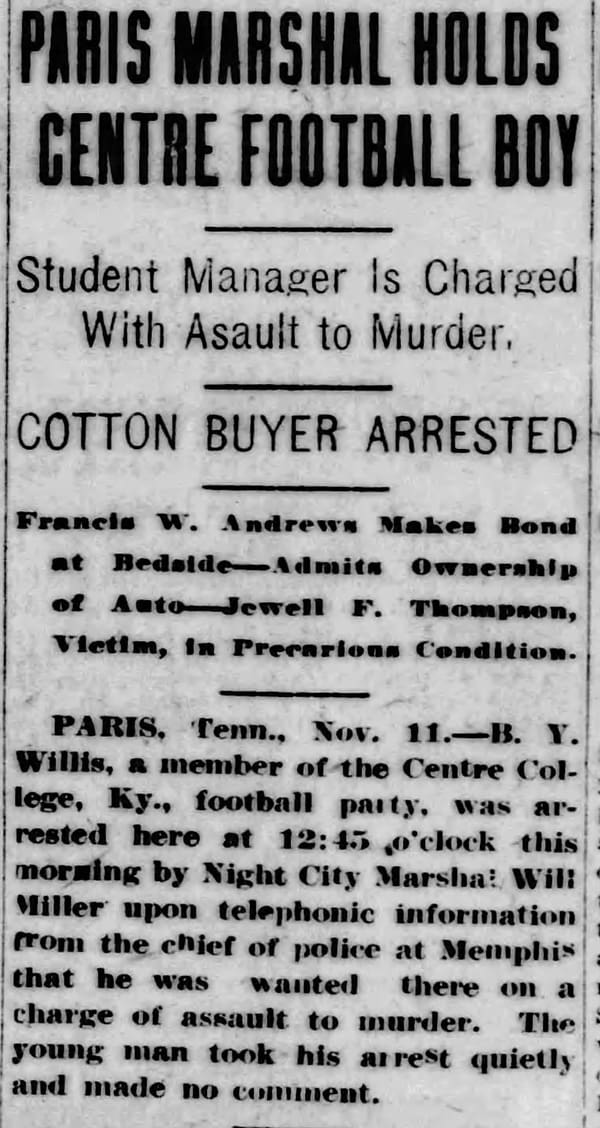
Willis is arrested and removed from the train in Paris, Tennessee
Detective Fox arrested the young student and accompanied him on a train back to Memphis and turned him over to the Memphis authorities, where he was jailed and on a "hit and run" charge.
Willis admitted that he had "hit," but denied he had "run."
"I stopped and rendered aid and called an ambulance. That was all I could do, so I left. I didn't speed off. I drove away at a normal speed."
Meanwhile, word was received from the hospital that Thompson was deteriorating and wasn't expected to live. That meant the charge would now be upped to manslaughter, and a jail sentence looked likely.
Prominent local Memphis businessmen Graham Southwick and J.A. Evans immediately came to the jail and posted $2,500 to free the shaken Willis, who proclaimed his innocence. Brown Young Willis, Sr. caught a Southern train to Danville from his home in Nicholasville, met up with President Montgomery of Centre, and together they boarded a L&N train at Junction City and headed to Memphis.
After the dire report from the hospital, the police went to re-arrest Willis, but another $2,500 in bail money was put up which kept him free.
The next morning there was a "whoops" report from the hospital. Thompson was sitting up, asking for breakfast, and wanted to go home. He shortly thereafter walked out of the hospital, none the worse for wear other than being somewhat hazy about the whole affair.
Brown Young Willis, Jr. graduated with his class in 1925.
Brown and I were classmates and Phi Delts together. We had heard all kinds of things about how he was in jail and may have to go to prison and no one could believe it. He was the nicest person in the world, and we were really relieved to see him back in Danville.
I remember that he said it would be a long time before he'd ever go back to Memphis, Tennessee!
